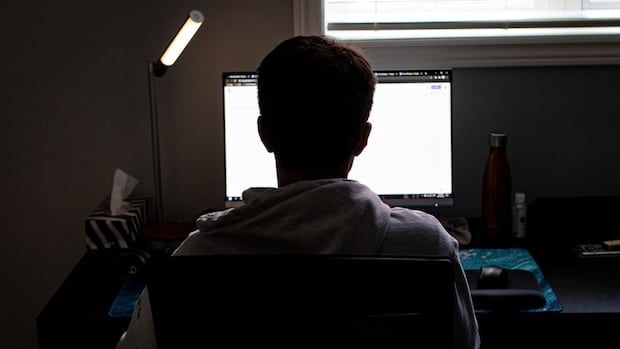British Columbia·NewWhile some have raised concerns about the burden a hybrid model will place on teachers, having to create lesson plans for both in-class and at-home learning, occupational therapist Cris Rowan worries about the effects of more screen time for teens. ‘It’s not healthy, it’s not effective as a learning tool and it’s addictive,’ occupational therapist saysCourtney Dickson · CBC News · Posted: Sep 04, 2025 9:00 AM EDT | Last Updated: 30 minutes agoSome students in Surrey, B.C., will switch to a hybrid learning model this school year, where they spend some time in classrooms and some learning online. (Evan Mitsui/CBC)While some students returned to full-time classroom learning this week, others were given the option to attend school both in class and online — a hybrid model.The Surrey School District is piloting the model for students in Grades 10 to 12 who have opted into the program. Courses will take place 50 per cent in the classroom, and 50 per cent online.”It’s about balance,” Surrey schools superintendent Mark Pearmain said. “This is not an entire course online.”According to a letter sent to parents in December, the program aims to help prepare kids for hybrid work in the future.And while some have raised concerns about the burden this will place on teachers, having to create lesson plans for both in-class and at-home learning, occupational therapist Cris Rowan worries about the effects of more screen time for teens. “It’s not healthy, it’s not effective as a learning tool and it’s addictive,” she told CBC’s On The Coast. “For all those reasons and many, many more, we really need to rethink screens in schools.”The Fraser Health Authority suggests, based on recommendations from the Canadian Paediatric Society, that children over the age of five should have less than two hours of recreational screen time per day — but there doesn’t appear to be much guidance around how much screen time is appropriate in a learning environment. Schools across the province have long suffered from overcrowding, and Surrey in particular has struggled as the city’s population has exploded in recent years. Pearmain said hybrid learning will help free up much-needed space in classrooms. But Rowan said the district should be putting the needs of children first — not those of the school board, teachers or the Ministry of Education. “Kids are not well today because they’re spending far too much time on sedentary screens,” Rowan said, pointing to rising issues with mental health in youth. “They’re isolated from each other, they’re over-stimulated … we’re neglecting kids by allowing all this screen time.”WATCH | Occupational therapist raises concerns with hybrid learning in Surrey schools:Therapist critical of introducing more screens to B.C. classroomsOn Tuesday, the Surrey School District said it would expand hybrid and online learning options in a bid to deal with overcrowding in B.C.’s largest school district. Cris Rowan, an occupational therapist, said there are many downsides to having screens in schools, and that children are being neglected by being allowed too much unsupervised screen time. She said these should be decisions taken in the children’s best interests, and not those of school district officials.She said the pilot project is “ridiculous” and suggested the district should be considering hybrid outdoor school, instead. “The kids would have better behaviour, they’d have better learning, they’d have higher grades, you’d have less fighting. They’d be happier,” she said. “Why are we making them sit in front of a screen that’s stimulating their brain but not growing their brain?”But the local parent advisory council president, Anne Whitmore, said for some students, this type of learning could be beneficial. “For some students, they thrive in this environment,” she said.”They’re in their home environment, they’re in their comfy clothes, they’re in their safe space. It allows their brain to relax and to be engaged in their learning and to do it sometimes at their own pace.”Anne Whitmore, president of the Surrey District Parents Advisory Council, says she believes the hybrid model will work well for certain students. (Ben Nelms/CBC)For others, she said, this model won’t work. “For other students, it’s absolutely critical that they have a person to co-regulate with, that they’re connected to their teacher, that they are engaged in the learning and that they’re drawn along and inspired in that way.”Supervision concernsAside from health issues, Rowan is concerned children learning online won’t be supervised the same way they would if they were in the classroom. “They’re kids and we cannot expect them to be responsible users of this stuff because as adults, we aren’t,” she said. Students could be exposed to predators, cyber bullying or violent content if left to their own devices, she argues. So, the role of the supervisor will fall to parents, Rowan said. “They can’t be expected to quit their jobs and sit behind their kid while they’re on this screen all day. And nor should they. It’s just an extremely unhealthy setup.”Pearmain said students will be interacting with teachers during online coursework and in person. They also have the option as to where they want to be when they do that online coursework, he said. For example, they could be working in a common space on campus. “Society is changing and so we really need to think and act to make sure that our kids are successful in the society they’re entering into,” Pearmain said.ABOUT THE AUTHORCourtney Dickson is an award-winning journalist based in Vancouver, B.C.With files from Johna Baylon and On The Coast
Expert worries about screen time, supervision as some B.C. students try hybrid learning this fall











